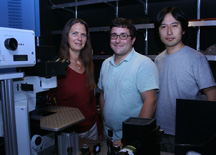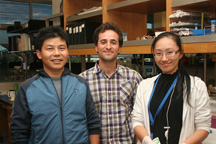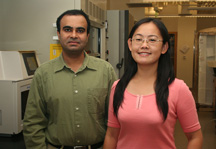

How Brain Circuits Are Built
By Kendall Powell
Hollis "Holly" T. Cline has studied leeches, tadpoles, and tobacco hornworms—impressively large caterpillars that secrete the nicotine they ingest. You might think she was the type of kid who loved to bring home slimy critters, but it's really the unique properties of these creatures' nervous systems that fascinate her. In particular, she's drawn to animals that go through metamorphosis, such as her laboratory creature of choice, Xenopus laevis, the African clawed frog.
"You have an animal in one form that then transforms into another," says Cline, a neuroscientist who joined The Scripps Research Institute's Departments of Cell Biology and Chemical Physiology this year. "From the point of view of the nervous system, the brain has to completely rewire to accommodate this new body it has to work with."
Cline's thoughtful, contemplative nature was evident even as a young graduate of Bryn Mawr College in Pennsylvania—she knew she wanted to study neuroscience, but she felt that she didn't have enough experience to choose a graduate program wisely. So first she took a job as a lab technician at Sloan Kettering Memorial Cancer Institute in New York City, knowing that with Rockefeller University and Weill Cornell Medical College literally across the street she could take the time to learn about the breadth of neuroscience until she settled on a graduate program.
She eventually chose Gunther Stent's laboratory at University of California, Berkeley, where she studied nervous system development in the leech. Although a leech's brain is not terribly sophisticated, in many ways this is an advantage for researchers.
"Stent chose an animal whose behaviors could be understood and quantified, so he could ask how the nervous system was built to accommodate those behaviors," Cline says. "He taught me that having the endpoint, the behavior, in mind helps your thinking remain 'clean'. He used the term 'good mental hygiene'—the clear logical thinking you need to do high quality science."
Cline has been practicing this approach ever since, applying it to help unravel how nervous systems develop. She is currently working on a number of diverse projects in this area—one that has to do with the control of cell proliferation in the brain, another that applies new viral technologies to understand how circuits form in the brain, and another investigating the role of neuronal inhibition in the processing of visual information.
"I gain deep satisfaction from understanding how the brain develops, how it works, and how it changes with experience," she says.
Trading One Ocean View for Another
Cline spent the last 14 years at Cold Spring Harbor Laboratory on Long Island, New York, where she was also director of research from 2002 to 2006. Coming to Scripps Research, Cline says she is moving from one beautiful location to another, and she hopes to gain a fresh perspective from new collaborations and different approaches to research questions.
"A new set of colleagues and a new physical environment can push someone to have novel ideas and a fresh point of view," Cline said. "Scripps is known for using genomics, proteomics, and therapeutics in a 'big science' way, and it will be fun for my group to think about our research in that context."
After a few brief months, she has already established connections with researchers at the neighboring Salk Institute and has shaped new projects with therapeutic goals in mind.
Cline is already well-known as someone with the determination and ingenuity needed to help decipher the big picture of brain development. In 2005, she won a National Institutes of Health Director's Pioneer Award, a $2,500,000 grant awarded to scientists who have demonstrated exceptional creativity in their field to pursue research questions that are high-risk, high-reward in nature.
"It was great to get together with my group and say, 'Let's do some dreaming: what problem could we address that would make a significant impact on the neuroscience community?'" recalls Cline. "One big step forward would be to understand the nervous system's connectivity or the map of information flow within the brain."
In other words, the group would like to come up with the basic wiring diagram for nervous system circuits, similar to a diagram for a car or an appliance that shows how each part is connected to other parts and whether the part's influence is positive or negative. "We need that diagram to move forward with understanding how the brain works," says Cline.
Cline decided to approach that question using her lab's unique set of experimental tools, which offer unprecedented access to observe the developing brain of the tadpole in almost real-time.
Opening a Window to the Brain
Frogs have a visual system that can be considered a simplified version of the mammalian system. In mammals, nerve cells in the eye send projections to two major brain areas, the superior colliculus and the lateral geniculate nucleus, that in turn send projections to the visual cortex, which does most processing of visual information.
"In humans, the superior colliculus coordinates motion in the field of vision with motor output—for example, when you see a tennis ball coming your way, your superior collicular coordinates that information with the signals to move your racquet to hit the ball," says Cline.
But in frogs and fish, which don't have a neocortex, all information processing occurs in the superior colliculus, which is known as the optic tectum in these animals. "That processing boils down to choosing whether the object is small and moving and something to eat, or big and moving and something to run away from," says Cline.
As a postdoctoral fellow, Cline began to ask questions about how the connections between the eye and the optic tectum form, and how they might change with different types of visual experience. Previous work had shown that visual experience was required for connections to form correctly, but it was still a mystery how experience controls brain development. It frustrated Cline that the techniques of the day only enabled her to infer that the differences she could see in the connections in different brain samples reflected dynamic changes in connections over time within an individual tadpole's brain. She recalls telling a colleague, "I've got to figure out how to see how these changes occur directly, or I've got to do something else entirely."
In 1990, she came across work by Scott Fraser and Nancy O'Rourke at University of California, Irvine, the first team to fluorescently label nerve axons in the eyes of living animals and collect high resolution time-lapse images of them through a laser-scanning confocal microscope. Cline grabbed the opportunity to learn the technique from the Irvine group and then went on to adapt and improve it for her own research. At Cold Spring Harbor Laboratory, her team built a laser scanning 2-photon microscope with improved spatial and temporal resolution, so that with time-lapse photography her lab could watch changes in the eye-brain circuitry as they occur during brain development.
Using this setup, Cline's laboratory has been able to expose tadpoles to visual experiences—rows of flashing LED lights—and then test how that experience shapes brain development. Her group has already shown that four hours of such visual stimulation causes new synapses to form and strengthens synapses already in place. This work is shedding light on how sensory stimulation is important for brain development.
"We're finding out that there is an optimal range of sensory input where the brain works pretty well," says Cline. "If you go to the ceiling or the floor of that range, then in a general sense the brain doesn't function so well."
The strength of synaptic connections has to be in that middle range for learning to occur properly. So too much or too little visual stimulation can be a bad thing for the developing brain—but how that translates to television viewing for toddlers is still anybody's guess at this point, Cline says.
Tinkering with the System
But there is much that Cline's experimental system might reveal. It can be used to test ideas about how the developing brain builds new circuits, changes circuits, or deletes circuits as an animal learns. Alternatively, it can be used to discover what happens when something goes wrong in brain development.
As part of her Pioneer Award research program, Cline hopes to capitalize on the properties of viruses that infect nerve cells, such as the rabies virus, to "trace and light up" the wiring diagram of the eye-to-brain circuit. A rabies virus infection spreads from the peripheral nerve, to the spinal cord, and eventually to the brain. If the virus could be modified to carry a fluorescent protein tag with it, then it would be like "using the virus as the FedEx man" leaving packages of fluorescent protein as it travels along up the circuit, she explains.
In another line of research, Cline is attempting to make tadpole models that mimic in a small way what goes wrong in the brains of autistic children. Although there is much controversy about what causes autism, many researchers agree that autistic children do not form proper brain connections in response to sensory stimulation. Cline's lab already has found a gene which, when mutated, prevents neurons from forming the proper synapses when stimulated visually with the flashing lights. Such a model animal could then be used to understand the defect and to look for drugs that might reverse the condition.
Another topic that Cline would like to explore is whether sensory experiences during development cause stem cells in the brain to proliferate and produce more neurons. "What happens if you put the tadpole in total darkness or if you give it a moving stimulus?" she asks. "Would this increase or decrease the generation of neurons?"
In her lab at Scripps Research, Cline will try to answer these and other questions, illuminating the factors that shape brain circuitry.
Send comments to: mikaono[at]scripps.edu



The Cline lab is helping to decipher the big picture
of brain development. Shown here are members of the team: (top) Professor
Hollis Cline, Research Associates James Demas, and Masateru Hiramoto;
(center) Research Associates Jianli Li, Lucio Schiapparelli, and Haiyan He;
(bottom) Research Associates Pranav Sharma and Shu-Ling Chiu.
